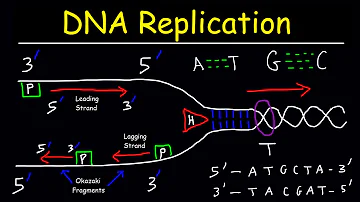What are Okazaki fragments and why are they important?
Innehållsförteckning
- What are Okazaki fragments and why are they important?
- Why are there Okazaki fragments?
- What is a Okazaki fragments in DNA?
- What is the purpose of Okazaki fragments quizlet?
- Why is lagging strand synthesized in fragments?
- What is the purpose of the origin of replication?
- Why is DNA replication important?
- What happens during the formation of Okazaki fragments quizlet?
- Where would you expect to find Okazaki fragments?
- Why do lagging strands occur?

What are Okazaki fragments and why are they important?
Okazaki fragments are small sections of DNA that are formed during discontinuous synthesis of the lagging strand during DNA replication. They are important because they allow for both daughter strands to be synthesized, which are necessary for cell division.
Why are there Okazaki fragments?
Okazaki fragments are formed on the lagging strand for the synthesis of DNA in a 5′ to 3′ direction towards the replication fork. Only one of the two strands of DNA would be replicated in an entity if not for these fragments. This would reduce the efficiency of the process of replication.
What is a Okazaki fragments in DNA?
Okazaki fragments are pieces of DNA that are transient components of lagging strand DNA synthesis at the replication fork.
What is the purpose of Okazaki fragments quizlet?
Okazaki fragments are short, newly synthesized DNA fragments that are formed on the lagging template strand during DNA replication. They are complementary to the lagging template strand, together forming short double-stranded DNA sections.
Why is lagging strand synthesized in fragments?
This strand is made in fragments because, as the fork moves forward, the DNA polymerase (which is moving away from the fork) must come off and reattach on the newly exposed DNA. This tricky strand, which is made in fragments, is called the lagging strand.
What is the purpose of the origin of replication?
The ori is the place where DNA replication begins, enabling a plasmid to reproduce itself as it must to survive within cells. The replicons of plasmids are generally different from the those used to replicate the host's chromosomal DNA, but they still rely on the host machinery to make additional copies.
Why is DNA replication important?
Replication is an essential process because, whenever a cell divides, the two new daughter cells must contain the same genetic information, or DNA, as the parent cell. ... Once the DNA in a cell is replicated, the cell can divide into two cells, each of which has an identical copy of the original DNA.
What happens during the formation of Okazaki fragments quizlet?
What happens during the formation of Okazaki fragments? DNA polymerase III adds nucleotides in the 5´ → 3´ direction. What principle is necessary to preserve the sequence of DNA during replication? The diagram below shows part of a DNA molecule that is being replicated.
Where would you expect to find Okazaki fragments?
the lagging strand Okazaki fragments are found on the lagging strand during replication. Because these fragments will not be attached together following strand synthesis, a protein is required to combine the fragments.
Why do lagging strands occur?
Why must there be a lagging strand during DNA synthesis? Explanation: The lagging strand exists because DNA is antiparallel and replication always occurs in the 5' to 3' direction.















